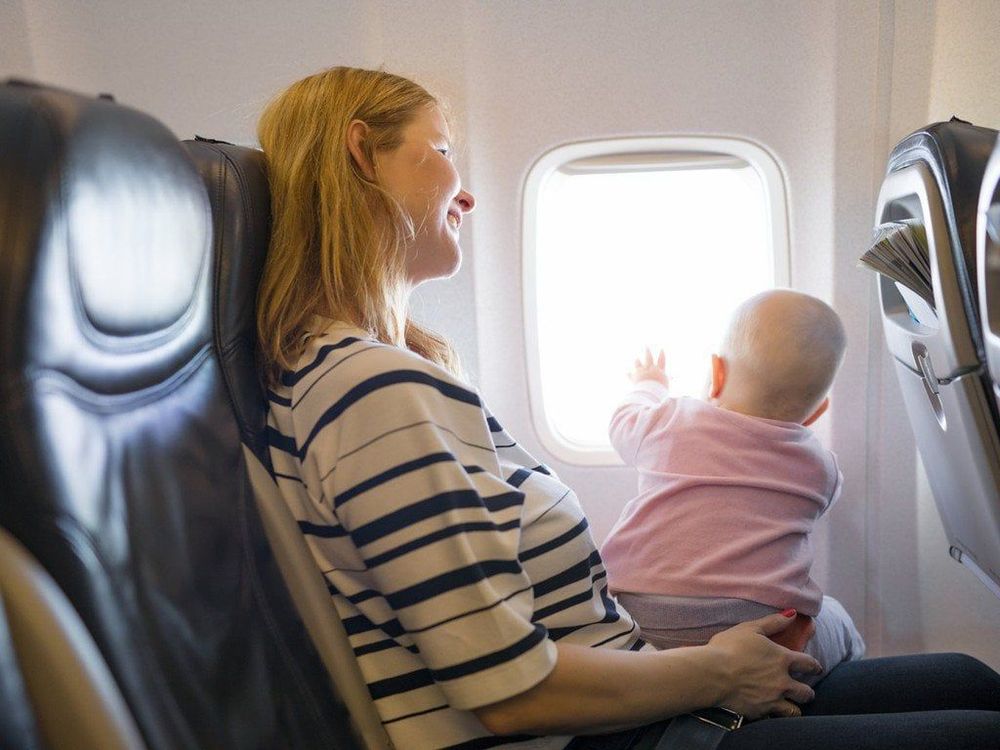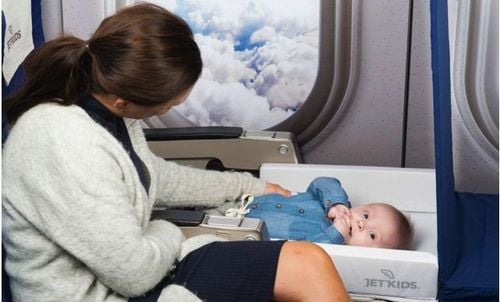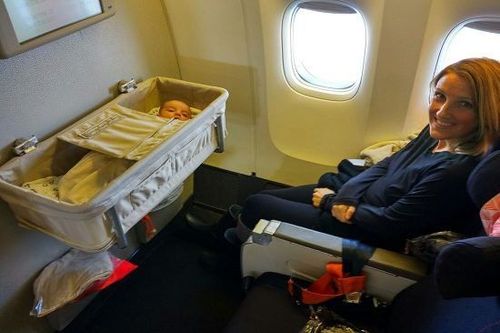This is an automatically translated article.
When you have to travel between two locations far apart, the choice of plane as a means of transport is understandable. But if you bring a baby with you, especially a newborn, there can be a lot of problems for you to worry about. However, if you know what to do and what to prepare, your flight with your baby will be smoother.
1. Some notes when preparing children to fly
Traveling with a baby can be stressful, especially when traveling by plane. There are a few things you need to keep in mind as you prepare for your baby's first flight.
Buy a ticket for your baby if you can: if possible buy a separate ticket for the child, then use a car seat that is securely fastened to the seat on the plane. This is the safest way for your baby to fly. Choose the right time of day to fly: you may want to fly during nap time, or even at night, when your baby will likely fall asleep during the flight. Know the rules when traveling by plane: check with your airline for check-in, carry-on baggage policies. Check your baby's health before you fly: if your baby is sick before your trip, have your doctor check for ear infections or other health problems before you depart. Prepare your baby: make sure your carry-on bag has extra clothes, diapers, wipes, food, pacifiers, toys and blankets for your baby. Reduce pressure on baby in flight: breastfeed, bottle-feed, or suck on a pacifier during takeoff and landing to reduce ear discomfort. Taking a baby on a plane is something that most parents worry about especially when it comes to flying their newborn baby for the first time. But planning and preparing well in advance can make for a better experience for your baby, you, and others on the plane.

Cho trẻ đi máy bay cần biết các quy tắc khi di chuyển bằng máy bay
2. When is the child old enough to fly?
In general, it is not advisable for infants to fly unless absolutely necessary immediately after birth. If possible, wait until the baby is 3 months old.
Airplane travel increases a newborn's risk of contracting infectious diseases, as the plane is a potential breeding ground for many disease-causing germs. Babies born prematurely, with chronic heart or lung conditions, or with upper or lower respiratory tract symptoms can also have problems with changing oxygen levels in the cabin. Parents should talk to their pediatrician before sending their child on a plane.
If there is an outbreak of measles in your area, or you plan to travel somewhere where there is a measles outbreak, your pediatrician may recommend that you give your baby an extra dose of MMR vaccine. This can be done as early as 6 months old.
3. Factors to consider before sending children on airplanes
Age of the baby: doctors do not recommend traveling by plane if it is not necessary immediately after birth. Newborns have developing immune systems, and air travel can increase the risk of infectious disease. If you choose to travel with an infant, wash your hands often or use hand sanitizer and avoid contact with travelers who appear sick on board. Baby's ears: pressure changes in the cabin cause temporary changes in middle ear pressure, which can cause ear pain. To help equalize pressure in your baby's ears, breastfeed, bottle-feed, or suck on a pacifier during takeoff and landing. It can help if you try to schedule feeding times so that your baby is hungry during these times. If your child has had ear surgery or has had an ear infection in the last two weeks, ask the doctor if he or she can fly. In addition, the noise level of the aircraft cabin is very loud, especially during take-off. Consider using cotton balls, noise-cancelling headphones, or small earplugs to limit your baby's exposure to this noise and make it easier for her to fall asleep.
Baby's breathing rate: during flight, the air pressure in the cabin is lower than the air pressure on land. This temporary change in oxygen levels is unlikely to cause problems for otherwise healthy babies. However, if your baby was born prematurely, has chronic heart or lung conditions, or has upper or lower respiratory tract symptoms, talk to your doctor before flying your baby. Baby safety seats: most infant car seats are certified for air travel. Although airlines generally allow infants to sit on a caregiver's lap during the flight, it is still recommended that infants be seated in a secure safety seat that is suitable for the aircraft. However, not all child car seats are certified for use on airplanes. Check the car seat label for this: "This seat is certified for use in motor vehicles and aircraft".
If you choose not to purchase an infant ticket, ask about availability when you board, in some cases you can assign an infant seat.

Khi quyết định cho trẻ đi máy bay cần cân nhắc về đội tuổi
4. Should children sit on their laps during the flight?
Most airlines don't require tickets for children under 2, but that means your baby will sit on your lap. If there is a breakdown or accident, you may not be able to protect your baby in your arms. If you're not buying a ticket for your baby, ask if the airline will allow you to use an empty seat. If your airline's policy allows this, take the time to look for an empty seat next to you.
The American Academy of Pediatrics (AAP) recommends that the safest way to fly a child on a plane is in a child safety seat - a device with a seat belt on an airplane that is intended for use with children.
5. What is the best seat on the plane for a baby?
Find rows of seats on a plane with more space. Exit rows should not be selected, for child safety reasons. If possible, choose a seat closer to the window. An aisle seat can pose a risk to infants during food service. Hot drinks delivered to passengers may spill and cause burns. In addition, children's small hands and feet can get stuck when the car passes. Seats in the aisle are also near the overhead luggage compartment, items and suitcases can fall, very dangerous.

Chọn vị trí có nhiêu không gian trên máy bay cho trẻ
6. Is there a way for babies to sleep on long flights?
Putting your child in a car seat or car seat is still the safest option. However, there are other options to help your baby sleep comfortably, especially on long-haul flights.
Baby bassinet: some airlines offer specialized airline devices that attach to the plane's bulkhead wall - the wall behind the showroom, or the toilet, or another cabin. In some premium cabins, they can be integrated into the seat compartment. For use in bulkhead rows. Most airline flights require an infant under 6 months of age and/or under 9kg (about 20 pounds), and who cannot sit up without assistance.. Ask the airline about the device. this when you book your ticket.
Sleeper chair: for an additional fee, some international airlines allow you to book 3 seats in a row with a lockable seat extension, creating a chaise longue or sleeper chair large enough for both parents and baby. Inflatable seat: some airlines allow you to bring your own, inflatable seat extension that your baby can use to lie down. These are fairly new products and not all airlines allow them to be used, so the airline employees when you buy the plane ticket. Of course you will have to buy a ticket for a separate baby seat, in order to be able to use an additional inflatable seat. Note: For all of the above options, your baby still needs to be strapped to the car seat or held in your lap during take-off, bad weather, and landing.
Safe sleeping practices still apply on planes: if your baby sleeps on your lap during the flight, be alert and check on your baby often. Make sure your baby can breathe easily and his face is not covered. If your baby sleeps on another device during the flight: check that the device is stable and flat.
7. Can liquid formula or breast milk expressed in a bottle be loaded onto the machine?
You can bring liquid formula or expressed breast milk in a bottle on board. But you must follow the airline's reasonable quantity rule.
Pack formula, expressed breast milk or water to mix with powder separately and have it ready for airline staff to know you have it. You can ask them not to go through the x-ray scanner, although this does not pose a health problem.

Sữa công thức dạng lỏng được phép mang lên máy bay
8. Ways to keep your baby comfortable and satisfied on the plane
Dress in layers: the temperature on the plane can vary a lot, especially if you're stuck waiting on the runway, so it's best to dress your child in layers. When you're choosing clothes, choose one that makes diaper changes in small spaces easier. Also, bring a change of clothes or two, in case disturbances occur during diaper changes or while you're breastfeeding. Bring a bag for dirty clothes. Be prepared for an earache: during takeoff and landing, the change in pressure between the outer and middle ear can be uncomfortable for your baby. Can help babies breastfeed or bottle-feed or suck on a pacifier. If the child has a cold or an ear infection, a dose of Acetaminophen or Ibuprofen may be helpful; Ask your doctor for the right dose for your baby. Keep in mind that sleeping in flight is better for everyone. If possible, travel at a time when your baby is naturally asleep, or consider trying to take a nap until you fly. A flight delay can backfire if the baby is exhausted and screaming instead of sleeping. Do not give your child over-the-counter medicines, such as Diphenhydramine, Benadryl,... to make them sleep during the flight. This is not recommended and sometimes medication can have the opposite effect.
These drugs can have serious side effects, especially if repeated doses are taken on long flights. If you get proper instructions and dosage from your doctor, try it at home first. Some children respond to medication by being more alert instead of drowsy.
Consider changing diapers right before boarding. Your baby will feel more comfortable without having to wear diapers that are already filled with waste. There are many planes with diaper changing tables in the restrooms, which you can use when you need to change diapers on the flight. If not, ask the flight attendant if there's a place on the plane where you can change the baby's towel. Some parents resort to changing diapers on a closed toilet seat. If you do try this, be sure to keep your hands on your baby's side at all times and carry disposable diaper changing pads.
Prepare a backup plan: You also need to plan for a later departure, prepare extra food for both you and your baby. Bring some extra toys and books and be ready to play with your baby the whole time. Tablets with video can be a good backup if toys and books no longer help. Don't mind the looks around you: in some cases despite your best efforts and plans, babies still cry sometimes. Know that you have done and are doing, all you can. At that point, one of the best ways you can calm your baby is to keep yourself calm. And remember that for every person looking at you, there are many people who have been through it and have them sympathize with you. Ask for help: ask your airline for help if you need help making your connecting flight. Having to carry your baby and luggage through a crowded airport can be a challenge, you can ask the help of the staff there. For children to be healthy and develop well, it is necessary to have a nutritious diet in terms of quantity and quality balance. If children are not provided with adequate and balanced nutrients, it will lead to diseases of excess or lack of nutrients, which adversely affect the comprehensive development of children in terms of physical, mental and motor skills. Parents should supplement their children with supporting products containing lysine, essential micro-minerals and vitamins such as zinc, chromium, selenium, and B vitamins to help fully meet the nutritional needs of children. At the same time, these essential vitamins also support digestion, enhance nutrient absorption, help improve anorexia, and help children eat well.
Parents can learn more:
Signs of zinc deficiency in children
Micronutrient deficiency and failure to gain weight in children
Please regularly visit Vinmec.com website and update useful information to take care of your child. Take care of the baby and the whole family.
References: babycenter.com, mayoclinic.org, healthychildren.org













